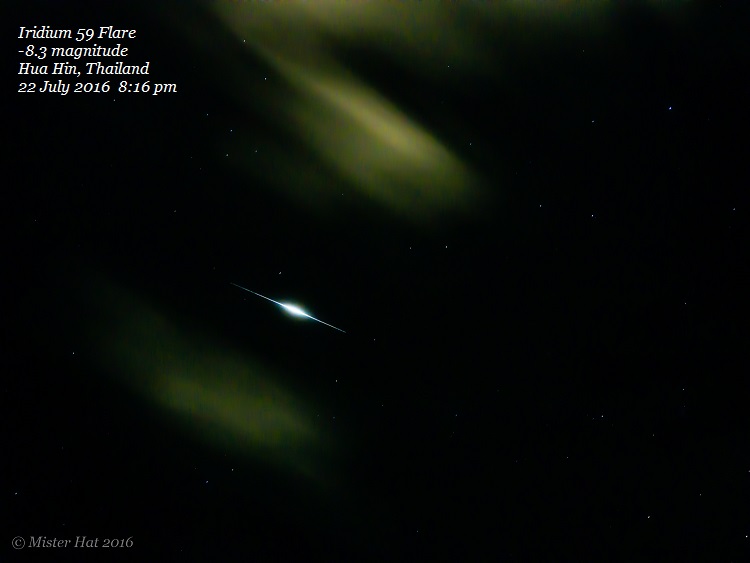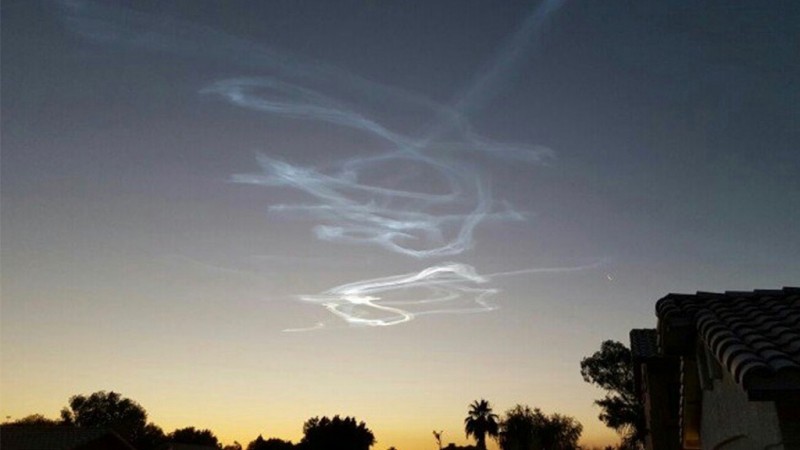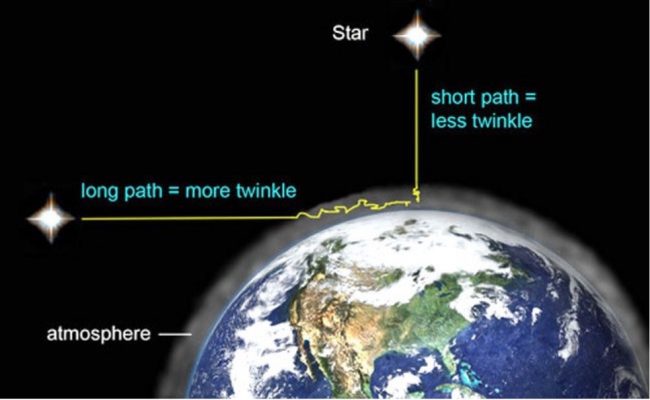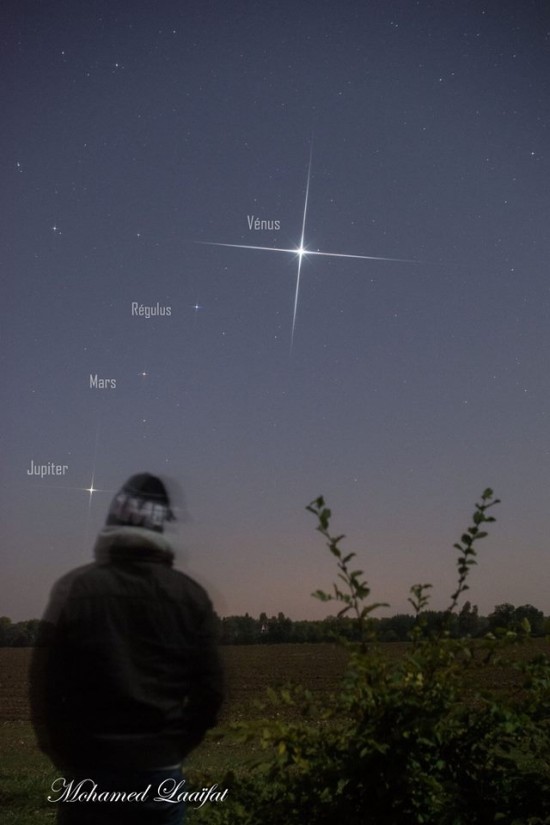

An experimental rocket test over Norway in 2009, which triggered many UFO reports. Read more about this photo.
If an unidentified flying object (UFO) were to appear in the sky, it is likely that it would be seen first by those who spend a lot of time gazing upwards: astronomers. But professional and amateur astronomers don’t usually observe any UFOs. Because they know what may appear up there, they’re able to identify most sightings of objects and events, no matter how strange they may look. Instead, UFO sightings are usually reported by the general public. During the pandemic times of 2020, reports of a perceived increase in sightings have appeared in many countries, but these have often been a matter of poor ability to interpret cell phone camera shots. This is also an indication of people taking more time to observe the sky above us, which is a trend we like.
For your reference, here’s a list of sky objects people frequently mistake for UFOs.
Flash in the sky: Rocket lights up South Florida. Did you see it? https://t.co/ImFT6wkT4X pic.twitter.com/otiFVPqYUZ
— Miami Herald (@MiamiHerald) September 2, 2015
Rocket launches. On the morning of September 2, 2015, many people in Miami, Florida looked up to catch a glimpse of the strange moving light seen above. Some labeled it as a UFO when posting photos to Twitter or Facebook, but others knew it was an Atlas V rocket launched from Cape Canaveral.
Some observers have seen a slow moving object displaying a strange single or double trail, which may even change its appearance over the moments you observe it. This can occur if an observer is fortunate enough to see a spacecraft just after being launched; you may be seeing one rocket stage separating from another, or the ignition of a new stage.
Take a look at the video below. This is a SpaceEx Falcon 9 launch in December, 2017, from the Vandenberg Air Force Base, as seen from Los Angeles, California, USA.
Used rocket bodies – tumbling objects orbiting our planet – also produce flashes in our night sky. After launching a satellite, most rocket bodies continue to orbit Earth for weeks, months or even years. As a rocket body tumbles in orbit, it may be visible as a dim moving “star” that might produce bright flashes as various sides of the tumbling object are exposed to sunlight.
An interesting sighting of this kind is a flash that appears to come from a static point in the sky. How is this possible? Geosynchronous satellites need to be placed in a very high orbit, some 22,200 miles (35,727 km) above Earth’s surface. After the launch of this sort of satellite, the rocket body that carried the satellite to orbit will also remain orbiting our planet. Instead of having a circular orbit it will have a highly elliptical (elongated) orbit. It might produce some peculiar flashes, which might be visible from Earth. How does it happen? Depending on the location and perspective of the observer, the erratic flashes of the rocket body from a geosynchronous satellite might appear to originate from an apparent static place in the sky. This rare occurrence is possible if the reflecting rocket body is more or less moving towards, or more or less departing, Earth as it pursues its stretched-out (elliptical) orbit. This is the same principle that occurs when a distant airplane appears to be static as it moves towards you. To the unaided eye, the subsequent flashes may give the impression that they are originating from the same area of the sky. If you are fortunate enough to witness this kind of flash in the sky, grab your binoculars! Magnification may confirm that the object is indeed moving slightly instead of remaining static.

An apparent static bright dot that was visible in daylight, was later confirmed to be a globe. A view using a telescope revealed it was this globe from Google’s Project Loon. Image via Eddie Irizarry.
Atmospheric balloons. Some observers reporting UFOs describe:
… an apparent planet or stationary bright object seen in broad daylight.
Large, round objects in the sky can be strange-looking. They may not appear to be moving. Different types of balloons and globes are being launched by various groups trying to do various things – for example, study Earth’s weather or atmosphere – and although these objects are slowly drifting on the wind, their distance from an observer might cause them to appear stationary in the sky. An example is Google’s Project Loon, listed by MIT Technology Review as one of 10 breakthrough technologies of 2015. Project Loon have launched a network of globes to test internet coverage with the goal to provide access to remote areas. They can gain an altitude of 60,000 feet (18,300 meters) or twice as high as commercial aircraft. Those balloons are reflective, and they appear bright in the sky. They can cause reports of UFOs sightings.

Vince Babkirk captured this flare from an iridium satellite on July 22, 2016. He wrote: “There were lots of fast moving clouds tonight, but the Iridium 59 satellite was supposed to appear … [the clouds] parted just in time for me to capture the flare.” Read more about iridium flare satellites.
Satellites travelling in groups have also been known to cause a stir, and we can likely expect an increase in reports when the Starlink satellite network becomes even more noticeable. Below is a video of a train of them passing by captured by Marco Langbroek in the Netherlands in 2019:

Especially when they’re seen in the west around sunset, jet contrails can look like falling objects. Image via Contrail Science.
Contrails from jet aircraft. Contrails are often confused with “slow-moving meteors” or “unannounced comets”, or other sorts of strange UFOs (in this case, often unidentified falling objects) by casual observers. These vapor or condensation trail are produced by high-altitude aircraft. They look impressive, especially when visible in the direction west around sunset. A contrail being illuminated by the setting sun appear as a slow falling, burning, meteor-like object from the sky. Of course, it’s not falling or burning at all. It’s just jet exhaust released into the atmosphere. Still, its distance from an observer can cause it to look slow-moving. Just know that these are not UFOs; they’re ordinary jets. They’re also not comets, by the way, which are detected and announced well in advance, usually many weeks or months before they become visible to the unaided eye (if they ever do). Comets are visible for many days or weeks, not for a few minutes. So, do not confuse contrails with comets…or any falling spacecraft.
Chinese lanterns. These sky lanterns or small hot air balloons are made of translucent paper and may look very curious from distance. People launch those colored lanterns at festivals, parties and other activities. Observers see a slow moving light high in the sky, and as soon as the small candle or the waxy cell is spent, the bright colored light that was seen in the sky “disappears”. Its bright light can be visible for several minutes in the sky. When a group of lanterns is launched, wind can send them at slightly different heights and directions, but a trio of Chinese lanterns is enough to cause reports of a formation of UFOs!

Smoke trail from a bright fireball, whose sightings were centered on Arizona, on June 2, 2016. Image via David Adkins via American Meteor Society. Later, a team from Arizona State University found the meteorite from this event.
Bright meteors. A meteor – or piece of debris from space – might leave a strange-looking trail as seen in the photo above. Or a bright meteor that happens to be moving toward you might appear as a short, bright light, which then disappears.
Some meteors – called fireballs – can be so bright that can lit up the night sky in such a way that can briefly turn the night into day. They’re actually pretty common, if you consider Earth as a whole. View the fireball logs from the American Meteor Society.

Why stars twinkle fiercely – sometimes even appearing to move around in the sky – when you see them near the horizon. Illustration by Bob King, aka AstroBob.
“Moving stars.” Atmospheric turbulence or different temperature layers in the atmosphere can make a bright star, especially a star low in the horizon, to show an erratic movement. Experienced observers see this frequently. It’s merely an effect of Earth’s atmosphere and is gradually reduced or eliminated as the star gets higher in the sky, and as the light from the star passes through less of Earth’s atmosphere (see the photo above).
An erratically moving object – a great candidate for being considered a UFO – typically turns out to be a bright star seen low in the sky.
Which brings us to what is perhaps the all-time most reported UFO …
Planet Venus. Venus is the brightest planet, and the third-brightest object in Earth’s sky after the sun and moon. If and when you see Venus, it’ll always be bright, much brighter than any other starlike object in the sky. And there are special times in the orbits of Venus and Earth around the sun when Venus looks even brighter than usual. These times of greatest brilliancy for Venus occur when the planet is about to pass between us and the sun, and, at such times, Venus typically looms low in our sky and shines with an eerie brilliant light. UFO reports always increase around then!
There are likely other objects that can be added to this list. If you know of any, tell us in the comments below.
Just know that – while some UFO sightings may be temporarily or indefinitely unexplained – most can be explained.
And don’t get too excited or scared if you ever see some rare or strange object in the sky; there’s no better way to investigate quickly than taking a closer look with optical aid. Keep a pair of binoculars handy! There are also excellent websites such as Heavens Above to check celestial happenings and local satellites passing by.
Bottom line: A reference list of he most common natural and human-made phenomena in the sky that people frequently mistake for UFOs.
from EarthSky https://ift.tt/3oUq4fK


An experimental rocket test over Norway in 2009, which triggered many UFO reports. Read more about this photo.
If an unidentified flying object (UFO) were to appear in the sky, it is likely that it would be seen first by those who spend a lot of time gazing upwards: astronomers. But professional and amateur astronomers don’t usually observe any UFOs. Because they know what may appear up there, they’re able to identify most sightings of objects and events, no matter how strange they may look. Instead, UFO sightings are usually reported by the general public. During the pandemic times of 2020, reports of a perceived increase in sightings have appeared in many countries, but these have often been a matter of poor ability to interpret cell phone camera shots. This is also an indication of people taking more time to observe the sky above us, which is a trend we like.
For your reference, here’s a list of sky objects people frequently mistake for UFOs.
Flash in the sky: Rocket lights up South Florida. Did you see it? https://t.co/ImFT6wkT4X pic.twitter.com/otiFVPqYUZ
— Miami Herald (@MiamiHerald) September 2, 2015
Rocket launches. On the morning of September 2, 2015, many people in Miami, Florida looked up to catch a glimpse of the strange moving light seen above. Some labeled it as a UFO when posting photos to Twitter or Facebook, but others knew it was an Atlas V rocket launched from Cape Canaveral.
Some observers have seen a slow moving object displaying a strange single or double trail, which may even change its appearance over the moments you observe it. This can occur if an observer is fortunate enough to see a spacecraft just after being launched; you may be seeing one rocket stage separating from another, or the ignition of a new stage.
Take a look at the video below. This is a SpaceEx Falcon 9 launch in December, 2017, from the Vandenberg Air Force Base, as seen from Los Angeles, California, USA.
Used rocket bodies – tumbling objects orbiting our planet – also produce flashes in our night sky. After launching a satellite, most rocket bodies continue to orbit Earth for weeks, months or even years. As a rocket body tumbles in orbit, it may be visible as a dim moving “star” that might produce bright flashes as various sides of the tumbling object are exposed to sunlight.
An interesting sighting of this kind is a flash that appears to come from a static point in the sky. How is this possible? Geosynchronous satellites need to be placed in a very high orbit, some 22,200 miles (35,727 km) above Earth’s surface. After the launch of this sort of satellite, the rocket body that carried the satellite to orbit will also remain orbiting our planet. Instead of having a circular orbit it will have a highly elliptical (elongated) orbit. It might produce some peculiar flashes, which might be visible from Earth. How does it happen? Depending on the location and perspective of the observer, the erratic flashes of the rocket body from a geosynchronous satellite might appear to originate from an apparent static place in the sky. This rare occurrence is possible if the reflecting rocket body is more or less moving towards, or more or less departing, Earth as it pursues its stretched-out (elliptical) orbit. This is the same principle that occurs when a distant airplane appears to be static as it moves towards you. To the unaided eye, the subsequent flashes may give the impression that they are originating from the same area of the sky. If you are fortunate enough to witness this kind of flash in the sky, grab your binoculars! Magnification may confirm that the object is indeed moving slightly instead of remaining static.

An apparent static bright dot that was visible in daylight, was later confirmed to be a globe. A view using a telescope revealed it was this globe from Google’s Project Loon. Image via Eddie Irizarry.
Atmospheric balloons. Some observers reporting UFOs describe:
… an apparent planet or stationary bright object seen in broad daylight.
Large, round objects in the sky can be strange-looking. They may not appear to be moving. Different types of balloons and globes are being launched by various groups trying to do various things – for example, study Earth’s weather or atmosphere – and although these objects are slowly drifting on the wind, their distance from an observer might cause them to appear stationary in the sky. An example is Google’s Project Loon, listed by MIT Technology Review as one of 10 breakthrough technologies of 2015. Project Loon have launched a network of globes to test internet coverage with the goal to provide access to remote areas. They can gain an altitude of 60,000 feet (18,300 meters) or twice as high as commercial aircraft. Those balloons are reflective, and they appear bright in the sky. They can cause reports of UFOs sightings.

Vince Babkirk captured this flare from an iridium satellite on July 22, 2016. He wrote: “There were lots of fast moving clouds tonight, but the Iridium 59 satellite was supposed to appear … [the clouds] parted just in time for me to capture the flare.” Read more about iridium flare satellites.
Satellites travelling in groups have also been known to cause a stir, and we can likely expect an increase in reports when the Starlink satellite network becomes even more noticeable. Below is a video of a train of them passing by captured by Marco Langbroek in the Netherlands in 2019:

Especially when they’re seen in the west around sunset, jet contrails can look like falling objects. Image via Contrail Science.
Contrails from jet aircraft. Contrails are often confused with “slow-moving meteors” or “unannounced comets”, or other sorts of strange UFOs (in this case, often unidentified falling objects) by casual observers. These vapor or condensation trail are produced by high-altitude aircraft. They look impressive, especially when visible in the direction west around sunset. A contrail being illuminated by the setting sun appear as a slow falling, burning, meteor-like object from the sky. Of course, it’s not falling or burning at all. It’s just jet exhaust released into the atmosphere. Still, its distance from an observer can cause it to look slow-moving. Just know that these are not UFOs; they’re ordinary jets. They’re also not comets, by the way, which are detected and announced well in advance, usually many weeks or months before they become visible to the unaided eye (if they ever do). Comets are visible for many days or weeks, not for a few minutes. So, do not confuse contrails with comets…or any falling spacecraft.
Chinese lanterns. These sky lanterns or small hot air balloons are made of translucent paper and may look very curious from distance. People launch those colored lanterns at festivals, parties and other activities. Observers see a slow moving light high in the sky, and as soon as the small candle or the waxy cell is spent, the bright colored light that was seen in the sky “disappears”. Its bright light can be visible for several minutes in the sky. When a group of lanterns is launched, wind can send them at slightly different heights and directions, but a trio of Chinese lanterns is enough to cause reports of a formation of UFOs!

Smoke trail from a bright fireball, whose sightings were centered on Arizona, on June 2, 2016. Image via David Adkins via American Meteor Society. Later, a team from Arizona State University found the meteorite from this event.
Bright meteors. A meteor – or piece of debris from space – might leave a strange-looking trail as seen in the photo above. Or a bright meteor that happens to be moving toward you might appear as a short, bright light, which then disappears.
Some meteors – called fireballs – can be so bright that can lit up the night sky in such a way that can briefly turn the night into day. They’re actually pretty common, if you consider Earth as a whole. View the fireball logs from the American Meteor Society.

Why stars twinkle fiercely – sometimes even appearing to move around in the sky – when you see them near the horizon. Illustration by Bob King, aka AstroBob.
“Moving stars.” Atmospheric turbulence or different temperature layers in the atmosphere can make a bright star, especially a star low in the horizon, to show an erratic movement. Experienced observers see this frequently. It’s merely an effect of Earth’s atmosphere and is gradually reduced or eliminated as the star gets higher in the sky, and as the light from the star passes through less of Earth’s atmosphere (see the photo above).
An erratically moving object – a great candidate for being considered a UFO – typically turns out to be a bright star seen low in the sky.
Which brings us to what is perhaps the all-time most reported UFO …
Planet Venus. Venus is the brightest planet, and the third-brightest object in Earth’s sky after the sun and moon. If and when you see Venus, it’ll always be bright, much brighter than any other starlike object in the sky. And there are special times in the orbits of Venus and Earth around the sun when Venus looks even brighter than usual. These times of greatest brilliancy for Venus occur when the planet is about to pass between us and the sun, and, at such times, Venus typically looms low in our sky and shines with an eerie brilliant light. UFO reports always increase around then!
There are likely other objects that can be added to this list. If you know of any, tell us in the comments below.
Just know that – while some UFO sightings may be temporarily or indefinitely unexplained – most can be explained.
And don’t get too excited or scared if you ever see some rare or strange object in the sky; there’s no better way to investigate quickly than taking a closer look with optical aid. Keep a pair of binoculars handy! There are also excellent websites such as Heavens Above to check celestial happenings and local satellites passing by.
Bottom line: A reference list of he most common natural and human-made phenomena in the sky that people frequently mistake for UFOs.
from EarthSky https://ift.tt/3oUq4fK


Aucun commentaire:
Enregistrer un commentaire